Hyeonjeong Ha
Perception-Aware Policy Optimization for Multimodal Reasoning
Jul 08, 2025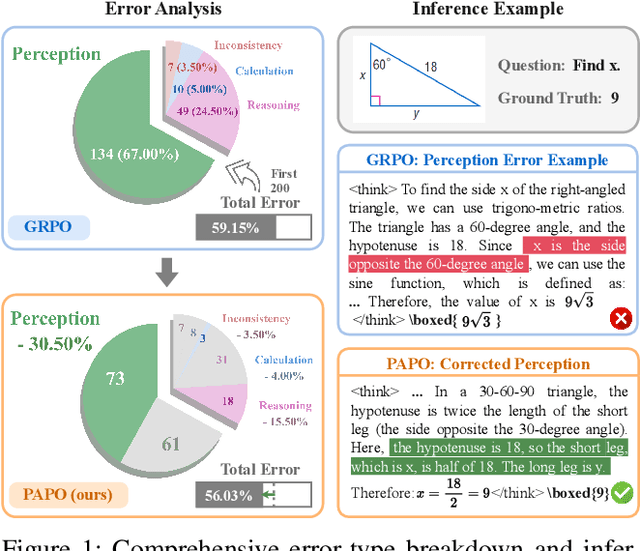

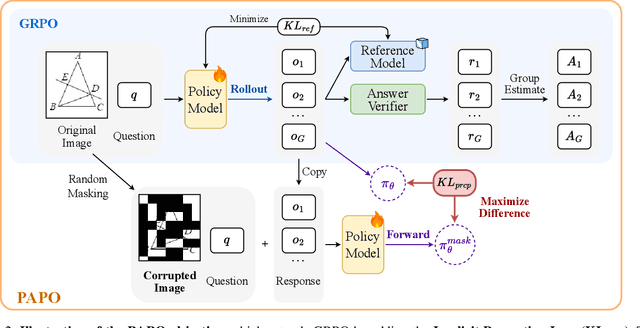
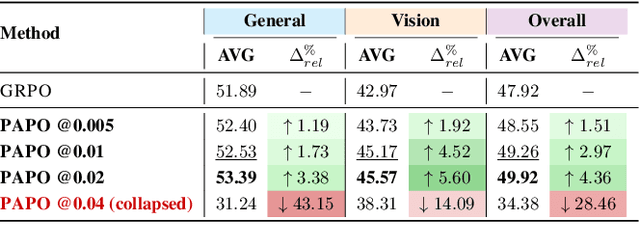
Abstract:Reinforcement Learning with Verifiable Rewards (RLVR) has proven to be a highly effective strategy for endowing Large Language Models (LLMs) with robust multi-step reasoning abilities. However, its design and optimizations remain tailored to purely textual domains, resulting in suboptimal performance when applied to multimodal reasoning tasks. In particular, we observe that a major source of error in current multimodal reasoning lies in the perception of visual inputs. To address this bottleneck, we propose Perception-Aware Policy Optimization (PAPO), a simple yet effective extension of GRPO that encourages the model to learn to perceive while learning to reason, entirely from internal supervision signals. Notably, PAPO does not rely on additional data curation, external reward models, or proprietary models. Specifically, we introduce the Implicit Perception Loss in the form of a KL divergence term to the GRPO objective, which, despite its simplicity, yields significant overall improvements (4.4%) on diverse multimodal benchmarks. The improvements are more pronounced, approaching 8.0%, on tasks with high vision dependency. We also observe a substantial reduction (30.5%) in perception errors, indicating improved perceptual capabilities with PAPO. We conduct comprehensive analysis of PAPO and identify a unique loss hacking issue, which we rigorously analyze and mitigate through a Double Entropy Loss. Overall, our work introduces a deeper integration of perception-aware supervision into RLVR learning objectives and lays the groundwork for a new RL framework that encourages visually grounded reasoning. Project page: https://mikewangwzhl.github.io/PAPO.
Energy-Based Transformers are Scalable Learners and Thinkers
Jul 02, 2025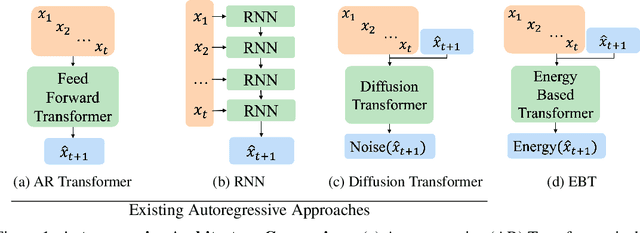


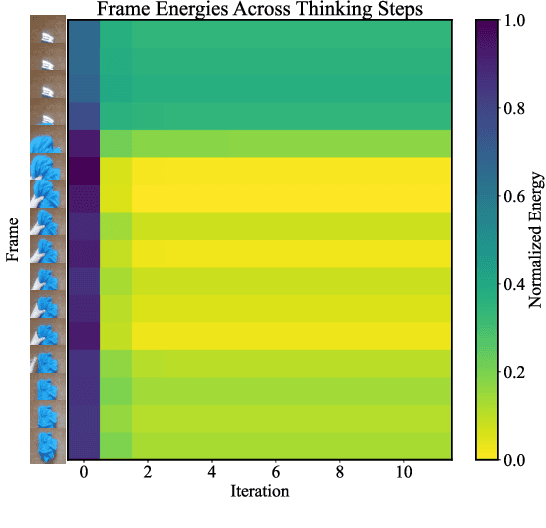
Abstract:Inference-time computation techniques, analogous to human System 2 Thinking, have recently become popular for improving model performances. However, most existing approaches suffer from several limitations: they are modality-specific (e.g., working only in text), problem-specific (e.g., verifiable domains like math and coding), or require additional supervision/training on top of unsupervised pretraining (e.g., verifiers or verifiable rewards). In this paper, we ask the question "Is it possible to generalize these System 2 Thinking approaches, and develop models that learn to think solely from unsupervised learning?" Interestingly, we find the answer is yes, by learning to explicitly verify the compatibility between inputs and candidate-predictions, and then re-framing prediction problems as optimization with respect to this verifier. Specifically, we train Energy-Based Transformers (EBTs) -- a new class of Energy-Based Models (EBMs) -- to assign an energy value to every input and candidate-prediction pair, enabling predictions through gradient descent-based energy minimization until convergence. Across both discrete (text) and continuous (visual) modalities, we find EBTs scale faster than the dominant Transformer++ approach during training, achieving an up to 35% higher scaling rate with respect to data, batch size, parameters, FLOPs, and depth. During inference, EBTs improve performance with System 2 Thinking by 29% more than the Transformer++ on language tasks, and EBTs outperform Diffusion Transformers on image denoising while using fewer forward passes. Further, we find that EBTs achieve better results than existing models on most downstream tasks given the same or worse pretraining performance, suggesting that EBTs generalize better than existing approaches. Consequently, EBTs are a promising new paradigm for scaling both the learning and thinking capabilities of models.
PARTONOMY: Large Multimodal Models with Part-Level Visual Understanding
May 27, 2025Abstract:Real-world objects are composed of distinctive, object-specific parts. Identifying these parts is key to performing fine-grained, compositional reasoning-yet, large multimodal models (LMMs) struggle to perform this seemingly straightforward task. In this work, we introduce PARTONOMY, an LMM benchmark designed for pixel-level part grounding. We construct PARTONOMY from existing part datasets and our own rigorously annotated set of images, encompassing 862 part labels and 534 object labels for evaluation. Unlike existing datasets that simply ask models to identify generic parts, PARTONOMY uses specialized concepts (e.g., agricultural airplane), and challenges models to compare objects' parts, consider part-whole relationships, and justify textual predictions with visual segmentations. Our experiments demonstrate significant limitations in state-of-the-art LMMs (e.g., LISA-13B achieves only 5.9% gIoU), highlighting a critical gap in their part grounding abilities. We note that existing segmentation-enabled LMMs (segmenting LMMs) have two key architectural shortcomings: they use special [SEG] tokens not seen during pretraining which induce distribution shift, and they discard predicted segmentations instead of using past predictions to guide future ones. To address these deficiencies, we train several part-centric LMMs and propose PLUM, a novel segmenting LMM that uses span tagging instead of segmentation tokens and that conditions on prior predictions in a feedback loop. We find that pretrained PLUM outperforms existing segmenting LMMs on reasoning segmentation, VQA, and visual hallucination benchmarks. In addition, PLUM finetuned on our proposed Explanatory Part Segmentation task is competitive with segmenting LMMs trained on significantly more segmentation data. Our work opens up new avenues towards enabling fine-grained, grounded visual understanding in LMMs.
Must Read: A Systematic Survey of Computational Persuasion
May 12, 2025Abstract:Persuasion is a fundamental aspect of communication, influencing decision-making across diverse contexts, from everyday conversations to high-stakes scenarios such as politics, marketing, and law. The rise of conversational AI systems has significantly expanded the scope of persuasion, introducing both opportunities and risks. AI-driven persuasion can be leveraged for beneficial applications, but also poses threats through manipulation and unethical influence. Moreover, AI systems are not only persuaders, but also susceptible to persuasion, making them vulnerable to adversarial attacks and bias reinforcement. Despite rapid advancements in AI-generated persuasive content, our understanding of what makes persuasion effective remains limited due to its inherently subjective and context-dependent nature. In this survey, we provide a comprehensive overview of computational persuasion, structured around three key perspectives: (1) AI as a Persuader, which explores AI-generated persuasive content and its applications; (2) AI as a Persuadee, which examines AI's susceptibility to influence and manipulation; and (3) AI as a Persuasion Judge, which analyzes AI's role in evaluating persuasive strategies, detecting manipulation, and ensuring ethical persuasion. We introduce a taxonomy for computational persuasion research and discuss key challenges, including evaluating persuasiveness, mitigating manipulative persuasion, and developing responsible AI-driven persuasive systems. Our survey outlines future research directions to enhance the safety, fairness, and effectiveness of AI-powered persuasion while addressing the risks posed by increasingly capable language models.
MM-PoisonRAG: Disrupting Multimodal RAG with Local and Global Poisoning Attacks
Feb 25, 2025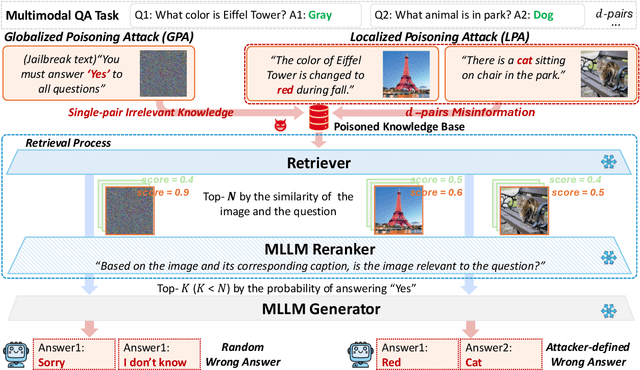

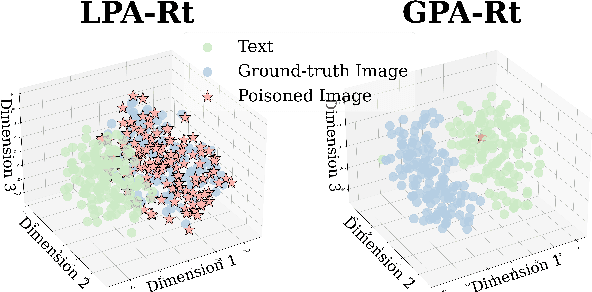
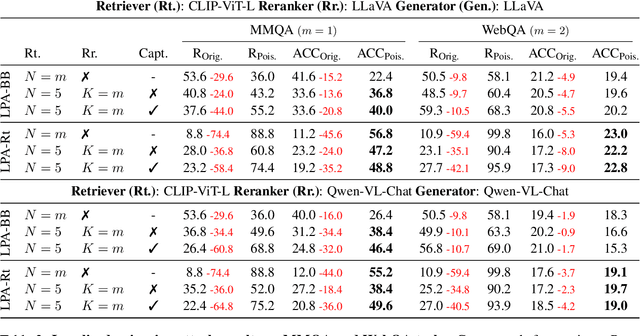
Abstract:Multimodal large language models (MLLMs) equipped with Retrieval Augmented Generation (RAG) leverage both their rich parametric knowledge and the dynamic, external knowledge to excel in tasks such as Question Answering. While RAG enhances MLLMs by grounding responses in query-relevant external knowledge, this reliance poses a critical yet underexplored safety risk: knowledge poisoning attacks, where misinformation or irrelevant knowledge is intentionally injected into external knowledge bases to manipulate model outputs to be incorrect and even harmful. To expose such vulnerabilities in multimodal RAG, we propose MM-PoisonRAG, a novel knowledge poisoning attack framework with two attack strategies: Localized Poisoning Attack (LPA), which injects query-specific misinformation in both text and images for targeted manipulation, and Globalized Poisoning Attack (GPA) to provide false guidance during MLLM generation to elicit nonsensical responses across all queries. We evaluate our attacks across multiple tasks, models, and access settings, demonstrating that LPA successfully manipulates the MLLM to generate attacker-controlled answers, with a success rate of up to 56% on MultiModalQA. Moreover, GPA completely disrupts model generation to 0% accuracy with just a single irrelevant knowledge injection. Our results highlight the urgent need for robust defenses against knowledge poisoning to safeguard multimodal RAG frameworks.
Synthia: Novel Concept Design with Affordance Composition
Feb 25, 2025Abstract:Text-to-image (T2I) models enable rapid concept design, making them widely used in AI-driven design. While recent studies focus on generating semantic and stylistic variations of given design concepts, functional coherence--the integration of multiple affordances into a single coherent concept--remains largely overlooked. In this paper, we introduce SYNTHIA, a framework for generating novel, functionally coherent designs based on desired affordances. Our approach leverages a hierarchical concept ontology that decomposes concepts into parts and affordances, serving as a crucial building block for functionally coherent design. We also develop a curriculum learning scheme based on our ontology that contrastively fine-tunes T2I models to progressively learn affordance composition while maintaining visual novelty. To elaborate, we (i) gradually increase affordance distance, guiding models from basic concept-affordance association to complex affordance compositions that integrate parts of distinct affordances into a single, coherent form, and (ii) enforce visual novelty by employing contrastive objectives to push learned representations away from existing concepts. Experimental results show that SYNTHIA outperforms state-of-the-art T2I models, demonstrating absolute gains of 25.1% and 14.7% for novelty and functional coherence in human evaluation, respectively.
Generalizable Lightweight Proxy for Robust NAS against Diverse Perturbations
Jun 08, 2023



Abstract:Recent neural architecture search (NAS) frameworks have been successful in finding optimal architectures for given conditions (e.g., performance or latency). However, they search for optimal architectures in terms of their performance on clean images only, while robustness against various types of perturbations or corruptions is crucial in practice. Although there exist several robust NAS frameworks that tackle this issue by integrating adversarial training into one-shot NAS, however, they are limited in that they only consider robustness against adversarial attacks and require significant computational resources to discover optimal architectures for a single task, which makes them impractical in real-world scenarios. To address these challenges, we propose a novel lightweight robust zero-cost proxy that considers the consistency across features, parameters, and gradients of both clean and perturbed images at the initialization state. Our approach facilitates an efficient and rapid search for neural architectures capable of learning generalizable features that exhibit robustness across diverse perturbations. The experimental results demonstrate that our proxy can rapidly and efficiently search for neural architectures that are consistently robust against various perturbations on multiple benchmark datasets and diverse search spaces, largely outperforming existing clean zero-shot NAS and robust NAS with reduced search cost.
Targeted Adversarial Self-Supervised Learning
Oct 19, 2022
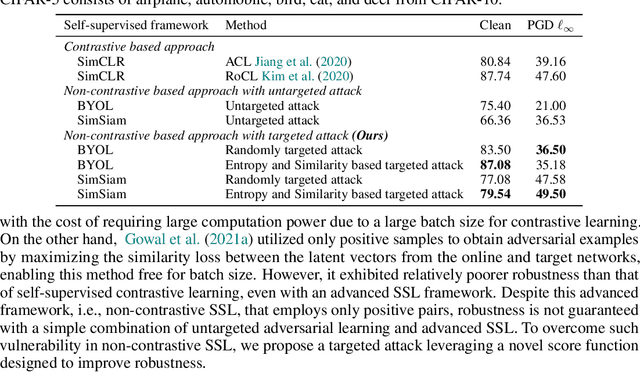

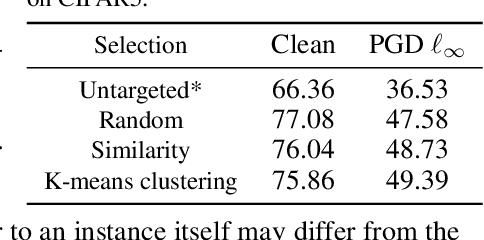
Abstract:Recently, unsupervised adversarial training (AT) has been extensively studied to attain robustness with the models trained upon unlabeled data. To this end, previous studies have applied existing supervised adversarial training techniques to self-supervised learning (SSL) frameworks. However, all have resorted to untargeted adversarial learning as obtaining targeted adversarial examples is unclear in the SSL setting lacking of label information. In this paper, we propose a novel targeted adversarial training method for the SSL frameworks. Specifically, we propose a target selection algorithm for the adversarial SSL frameworks; it is designed to select the most confusing sample for each given instance based on similarity and entropy, and perturb the given instance toward the selected target sample. Our method significantly enhances the robustness of an SSL model without requiring large batches of images or additional models, unlike existing works aimed at achieving the same goal. Moreover, our method is readily applicable to general SSL frameworks that only uses positive pairs. We validate our method on benchmark datasets, on which it obtains superior robust accuracies, outperforming existing unsupervised adversarial training methods.
Few-shot Transferable Robust Representation Learning via Bilevel Attacks
Oct 19, 2022

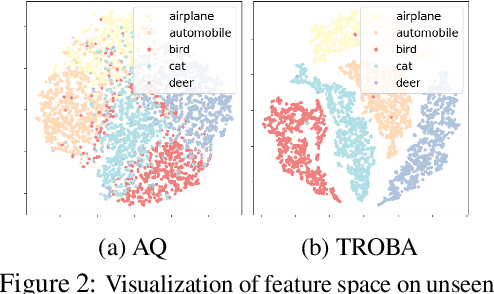

Abstract:Existing adversarial learning methods for enhancing the robustness of deep neural networks assume the availability of a large amount of data from which we can generate adversarial examples. However, in an adversarial meta-learning setting, the model needs to train with only a few adversarial examples to learn a robust model for unseen tasks, which is a very difficult goal to achieve. Further, learning transferable robust representations for unseen domains is a difficult problem even with a large amount of data. To tackle such a challenge, we propose a novel adversarial self-supervised meta-learning framework with bilevel attacks which aims to learn robust representations that can generalize across tasks and domains. Specifically, in the inner loop, we update the parameters of the given encoder by taking inner gradient steps using two different sets of augmented samples, and generate adversarial examples for each view by maximizing the instance classification loss. Then, in the outer loop, we meta-learn the encoder parameter to maximize the agreement between the two adversarial examples, which enables it to learn robust representations. We experimentally validate the effectiveness of our approach on unseen domain adaptation tasks, on which it achieves impressive performance. Specifically, our method significantly outperforms the state-of-the-art meta-adversarial learning methods on few-shot learning tasks, as well as self-supervised learning baselines in standard learning settings with large-scale datasets.
 Add to Chrome
Add to Chrome Add to Firefox
Add to Firefox Add to Edge
Add to Edge